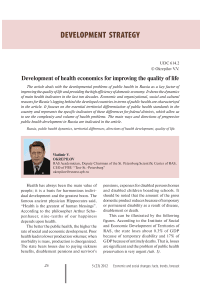Development of health economics for improving the quality of life
Автор: Okrepilov Vladimir Valentinovich
Журнал: Economic and Social Changes: Facts, Trends, Forecast @volnc-esc-en
Рубрика: Development strategy
Статья в выпуске: 5 (23) т.5, 2012 года.
Бесплатный доступ
The article deals with the developmental problems of public health in Russia as a key factor of improving the quality of life and providing the high efficiency of domestic economy. It shows the dynamics of main health indicators in the last two decades. Economic and organizational, social and cultural reasons for Russia’s lagging behind the developed countries in terms of public health are characterized in the article. It focuses on the essential territorial differentiation of public health standards in the country and represents the specific indicators of these differences for federal districts, which allow us to see the complexity and volume of health problems. The main ways and directions of progressive public health development in Russia are indicated in the article.
Russia, public health dynamics, territorial differences, directions of health development, quality of life
Короткий адрес: https://sciup.org/147223392
IDR: 147223392 | УДК: 614.2
Текст научной статьи Development of health economics for improving the quality of life
Federal district 2000 2005 2006 2007 2008 2009 Central 66.1 66.3 67.3 68.1 68.5 69.4 North-West 64.5 64 65.6 67 67.4 68.2 Southern 67.3 68.1 68.8 69.7 70.1 70.6 Volga 65.5 65.3 66.5 67.2 67.6 68.5 Ural 64.6 65.2 66.8 67.6 67.9 68.6 Siberian 63.7 62.8 64.7 65.7 66.2 67 Far Eastern 63.2 62.2 63.9 64.9 65 65.9 RF, on average 65.3 65.3 66.6 67.5 67.9 68.7 Note. The calculations of life expectancy index, as well as the analysis of other demographic indicators, given in the article, do not include the data about the North Caucasian Federal District, because there are no these figures till 2010 in the database of the Federal State Statistics Service. Source: Databases of the Federal State Statistics Service. Available at:
Federal district 2000 2005 2006 2007 2008 2009 2010 2011 Central Birth rate 7.4 8.8 9 9.7 10.3 10.8 10.7 10.7 Mortality rate 17 17.4 16.7 16.1 16.1 15.5 15.2 13.9 North-West Birth rate 7.7 9.3 9.4 10.2 10.7 11.3 11.4 11.4 Mortality rate 16.4 17.7 16.6 15.6 15.7 15.2 14.9 13.9 Southern Birth rate 8.6 10 10.2 11.1 11.8 11.9 11.8 11.8 Mortality rate 15 15.6 15 14.5 14.4 14.1 14.1 13.7 Volga Birth rate 8.8 9.8 10.1 11.1 11.8 12.1 12.4 12.4 Mortality rate 15.3 16.5 15.6 15.2 15.1 14.6 15 14.3 Ural Birth rate 9.2 11.1 11.4 12.4 13.2 13.6 14.1 14.2 Mortality rate 14.4 14.8 13.8 13.3 13.3 12.9 13 12.7 Siberian Birth rate 9.7 11.4 11.6 12.7 13.7 14 14.1 14.1 Mortality rate 14.6 16.5 15.1 14.4 14.4 13.9 14.2 13.7 Far Eastern Birth rate 9.7 11.5 11.5 12.3 12.6 13 13.2 13.2 Mortality rate 13.2 15.3 14 13.5 13.6 13.3 13.8 13.5 Russian Federation, on average Birth rate 8.7 10.2 10.4 11.3 12.1 12.4 12.5 12.6 Mortality rate 15.3 16.1 15.2 14.6 14.6 14.2 14.2 13.5 Source: Databases of the Federal State Statistics Service. Available at:
Mortality causes Central FD North West FD Southern FD Volga FD Ural FD Siberian FD Far Eastern FD RF on average* Cardiovascular diseases 917.71 860.82 828.28 850.87 674.45 720.02 735.75 805.88 Neoplasms 227.16 229.37 212.63 192.83 200.82 208.06 190.97 205.10 External causes 124.89 156.26 115.20 173.99 173.42 203.44 202.45 151.72 Diseases of the digestive system 64.10 73.86 61.17 68.07 62.16 65.82 78.09 64.36 Diseases of the respiratory system 47.55 48.81 40.59 59.34 53.31 68.29 58.83 52.34 Some infectious and parasitic diseases 14.93 23.51 25.58 21.95 33.37 37.49 32.56 23.51 Suicides 14.51 21.60 17.69 30.36 30.16 36.53 34.04 23.42 All the types of transportation accidents 20.45 18.83 18.31 20.74 19.26 20.63 22.42 19.98 Accidental alcohol poisoning 11.80 17.30 4.73 15.95 13.10 22.27 13.18 13.39 Murders 9.28 12.43 8.32 12.61 15.95 23.05 25.61 13.26 Total number of deaths 1517.54 1491.31 1406.32 1503.26 1297.54 1418.10 1376.38 1419.16 * Ranked by prevalence in the Russian Federation. Source: Database of the Federal State Statistics Service. Available at: the most common of them are suicides and transport accidents. It should be noted that there are higher death rates of neoplasms in the NorthWest and Central Federal Districts than in the country on average (229.37 and 227.16 cases per 100 thousand people, respectively).
Source: Federal State Statistics Service. Available at: countries (fig. 5). Consequently, most people have not enough income to supply other vital needs.
This conclusion is confirmed by the results of another survey conducted by the All-Russian Public Opinion Research Centre (VTSIOM): more than half of people do not invest their spare money, because they simply do not have them. And the share of such people has increased over three years. Of course, it is rather difficult to find money to invest them in the health in these conditions (fig. 6) .
This means not only, for example, the payment for classes in the pool or gym. The people in Russia have to save not only on food but on medicines due to a lack of funds. The results of the survey, conducted by VTSIOM specialists in autumn in 2011, show that 58% of respondents consider their medical products expenses as burdensome for their budgets. 19% of respondents (almost – one in five!) claim that they have no money to buy even the essential medicines (fig. 7) .
Figure 5. Food expenses in the world (in % of personal income, national average)
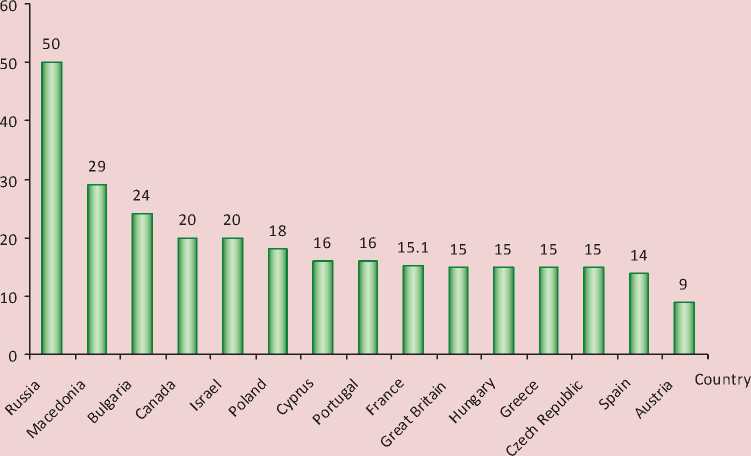
Figure 6. Where do the Russians invest their spare money?
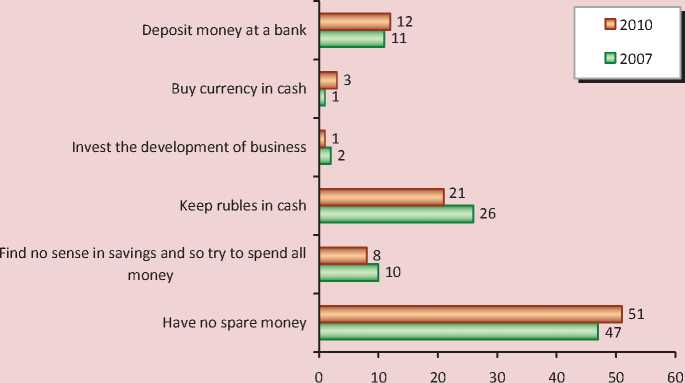
Population incomes are directly related to improving their living conditions, which affect the health. There is a concept of “affordable housing” that is defined by the numbers of annual salaries of a typical worker required to buy a typical one-bedroom apartment. Comparing some cities of Russia and other countries shows that housing prices are higher in Russia than in Western countries, while wage rates are lower (fig. 8).
As a result, according to housing supply, Russia ranks 80 among 200 countries; it is inferior to Latin America, Africa and the Middle East.
Figure 7. The results of the survey of Russian citizens on the appropriateness of purchasing drugs in 2011
I have no money to buy even the essential medicines; 19%
I buy the essential medicines but these expenses are significant for my budget; 21%
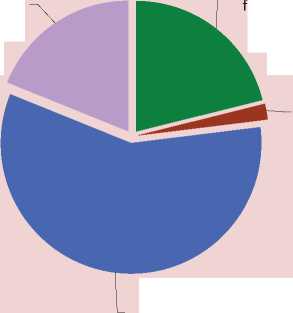
It’s difficult to answer;
2%
I can easily buy all the essential medicines; 58%
Figure 8. Housing affordability
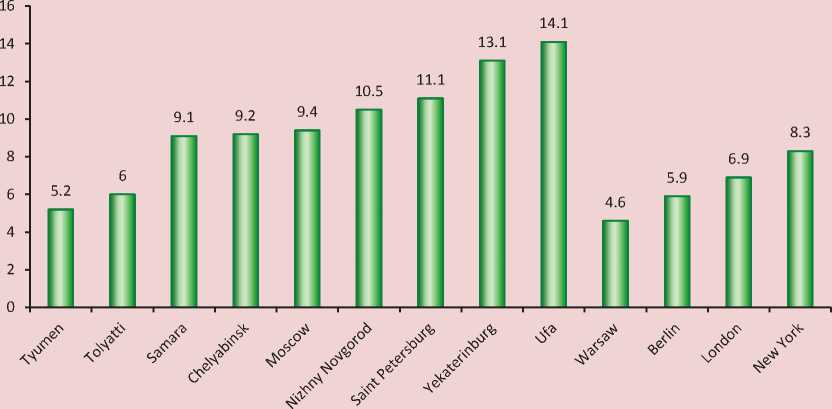
Source: Data of the Fund “The Institute for Urban Economics”.
There are 21 square meters of housing per person on average in our country, while the average supply of housing amounts to 40 – 60 square meters per person in the developed European countries and 70 square meters in the USA. But it’s not just the size of living space.
Housing comfort is much more important. According to Academician A.G. Aganbegyan, houses in Western countries are equipped with a refrigerator, gas or electric stove, microwave oven, dishwasher, washing machine, air conditioning, multiprogram television, modern telephone and Internet, garage for one or two cars. In Russia, a quarter of the housing is not equipped with sewerage and water supply system, and more than half of houses do not have hot water supply.
The rapid deterioration of available housing is a huge problem (fig. 9) . Complete housing overhaul has not been carried out over the last two decades. As a result, today the amount of dilapidated housing in Russia is more than one billion square meters. At the same time, new housing construction is small and often the quality of these buildings is poor.
The second health factor – medical – is associated with human treatment capabilities. International research company EPSI that regularly measures customer satisfaction with health services in 20 countries puts Russia in the last place with a satisfaction index of 56.9 points out of a possible 100. As it has been already noted, medicine expenses have been increased significantly in our country in the recent years. Unfortunately, these funds are aimed at the development of medicine in large cities, while the developmental level of rural medicine remains extremely low. This leads to extreme regional differences.
According to the report “Millennium Development Goals”, prepared by a group of UN experts, the world rural maternal and infant mortality rate is 40% higher than the urban one. This indicator is 50% in our country,
The third factor – environmental – is associated with the environmental influence over the people. Environment protection is troubled in our country. According to the Prime Minister’s assessment, about 15% of Russian territory is in critical environmental conditions. There are mainly ecologically poor industries such as metallurgy, oil and gas complex in the Russian economy; and clean industries, for example, electronics, are not developed.
According to the polls, the majority of citizens believe that the environmental situation has deteriorated in their region in the recent years, and they are afraid of ecological disasters.
Firstly, today, as a result of increased pollution, clean rivers remain only in Kamchatka. One third of population lives in the
Figure 9. The share of ramshackle and failing housing stock in the total housing area in 2010, %
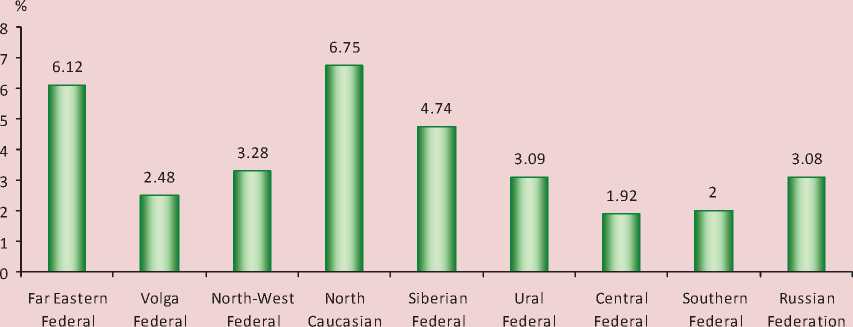
Federal
District
District
District
District
District
District
District
District (since 2010)
Source: Federal State Statistics Service.
regions where there are no efficient waste water treatment facilities, i.e. water is not purified effectively; there are old rusty pipes in most houses; 40% of urban water supply systems are in disrepair. Thus, according to the polls, one third of people drink tap water, they do not filter or boil it, i.e. there is a threat to the health of 30 million people.
Secondly, half of urban people live in the regions where air pollution level is characterized as high and very high. Naturally, they include the major megalopolises of the country. And there has been an increase in air pollution over the last ten years in 16 of 34 cities in Russia. And, of course, increasing urban transport contributes a lot to air pollution. In large cities, the share of motor transport accounts for 90% of emissions. It should be also noted that hundreds of thousands of people in Russia live in the sanitary protection zones of industrial enterprises, i.e. in the territories where air pollution is particularly high, and according to Russian legislation, one cannot live in these zones.
Thirdly, the state of soils in Russia is poor. In the cities they are intensely polluted with cadmium, arsenic, antimony, radioactive substances. But soil contamination with lead caused by car exhaust is the most trouble some one.
Lead has the most negative impact on human health. Women and men reproductive systems are damaged, and there is a decline in children mental development and increase in childhood mental disorders. According to ecologists, lead contamination covers all the territories of Russia. However, effective measures to reduce lead emissions have not been developed yet.
There is the most unfavorable situation with air pollution emission in the Ural and Siberian Federal Districts. The need to decrease dirty discharge is actual in the Central, North-West and Volga Federal Districts (tab. 6) .
Finally, the fourth factor affecting health is social , which is determined by human abilities to perceive oneself as a full member of society. At the same time, the social and psychological conditions in the Russian society cannot be considered as satisfactory. Russia is one of the most “disturbing” countries the world, along with Sudan, Iraq and Somalia. Russian people die of stress due to the unstable situation in the country 20 times more often than 30 years ago.
There are such common habits in Russia as smoking and alcohol consumption that lead to the decline in health. Tobacco corporations have found huge market outlets in Russia. The number of smokers is almost 1.5 times more in our country than the world average.
Table 6. The amount emissions of pollutants into the atmospheric air and dirty discharge into surface water sources in the federal districts of Russia
|
Federal district |
Emissions of pollutants into the atmospheric air due to stationary sources (thsd. t)* |
Dirty discharge into surface water sources (bln. sq. m) |
||||||
|
2000 |
2005 |
2009 |
2010 |
2000 |
2005 |
2009 |
2010 |
|
|
Central |
1597 |
1496 |
1577 |
1618 |
4742 |
4341 |
3596 |
3761 |
|
North-West |
2335 |
2254 |
2176 |
2389 |
3579 |
3192 |
2830 |
3088 |
|
Southern |
772 |
617 |
629 |
648 |
1752 |
1409 |
1409 |
1446 |
|
North-Caucasian |
143 |
185 |
152 |
138 |
637 |
496 |
445 |
390 |
|
Volga |
2930 |
3071 |
2567 |
2513 |
3858 |
3162 |
2674 |
2883 |
|
Ural |
4562 |
6296 |
5262 |
5105 |
1773 |
1681 |
1702 |
1860 |
|
Siberian |
5604 |
5615 |
5789 |
5868 |
2914 |
2575 |
2348 |
2218 |
|
Far Eastern |
876 |
890 |
869 |
836 |
1036 |
871 |
848 |
870 |
|
RF, on average * |
18.8 |
20.4 |
19.0 |
19.1 |
20291 |
17727 |
15854 |
16516 |
* In Russia – in mln. t.
Source: Data of Federal State Statistics Service. Available at:
43.9 million people or about 40% of the adult population smoke in Russia. 7 out of 10 men and 4 out of 10 women aged 19 – 44 smoke in our country (fig. 10) .
300 billion rubles of budget money are spent annually to treat the diseases associated with smoking, although tobacco companies’ assignments to the budget account for only 88 billion rubles.
According to the study “Smoking beginner”, which was published in the Arguments and Facts Newspaper, 100% of homeless teenagers, 31.7% of girls and 24.4% of boys smoke in St. Petersburg.
However, the measures that are taken recently give the hope that this situation will be improved. The Ministry of Health has prepared a draft of a new “anti-smoking” law. According to it, for example, smoking will be prohibited in the workplace, the territories of educational, medical, cultural and sporting institutions, catering organizations, in the areas of public recreation and public transport. Tobacco advertising and tobacco companies’ sponsorship of any events and activities will be completely banned.
However, of course, it is necessary to think about ensuring the rights of smokers, for example, through establishing the special places equipped with modern ventilation devices.
Alcoholism expansion is another trouble; the data of the Ministry of Health and Social Development shows the extent of the problem: alcohol consumption in Russia accounts for 15 liters of pure alcohol per capita annually. However, the World Health Organization considers that the level of alcohol consumption equal to 8 liters is dangerous to the health of the nation. Each additional liter beyond this limit takes away 11 months of men life and 4 months of women life. Russia has gone on before other countries in the world (fig. 11) .
Figure 10. Smoking in Russia (the share of smokers, %)
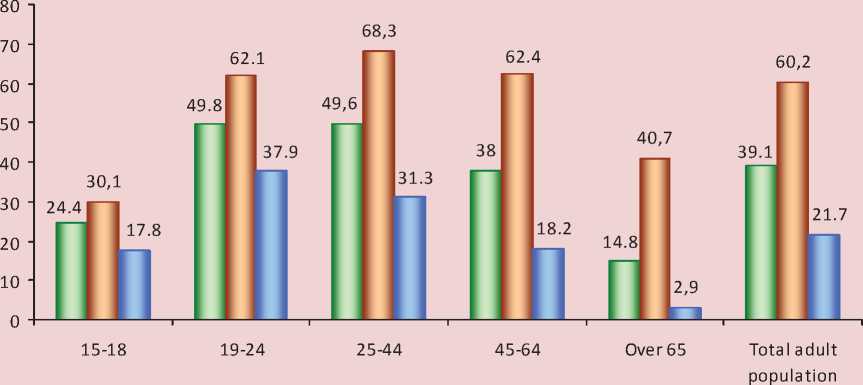
Tota l Men Women
Source: Global survey of adults about tobacco use. Russian Federation, 2009.
Figure 11. Alcohol consumption in the Russian Federation and Western countries
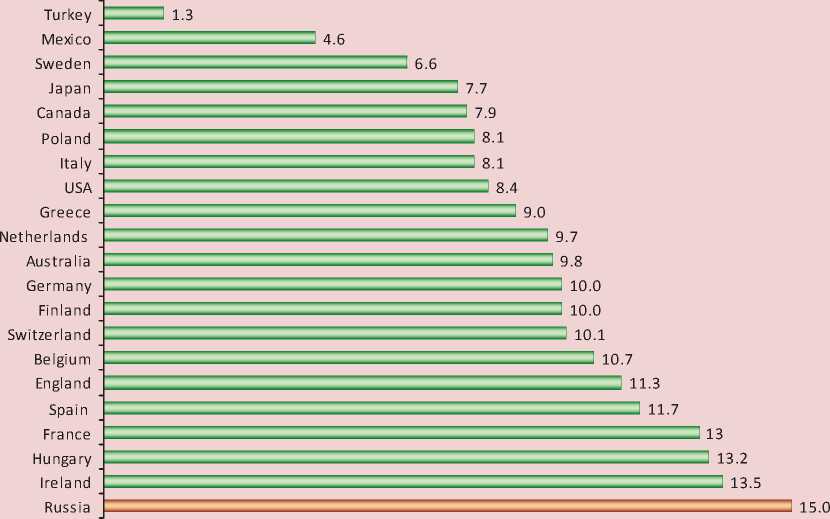
The incidence of such socially dangerous diseases as HIV, tuberculosis and diabetes is revealing. According to the Federal State Statistics Service, there is no any improvement in this indicator, and on the contrary, these morbidity rates are increasing in the whole country. For example, the number of HIV-infected people has increased by 30% since 2005 (fig. 12) .
This sad result is largely due to negative social phenomena: in Russia such disease as HIV is transmitted mainly through drug addicts’ syringes. The problem of drug addiction in Russia acquires the features of a national disaster. According to the Ministry of Health and Social Development, the number of drug addicts increases by 4.5% every year.
Today, unfortunately, Russia lags far behind the developed countries in the economic and social spheres, including the health sector. There are many problems that should be solved as soon as possible.
The government understands this and takes some steps to solve them. For example, the Concept of the Demographic Policy in the Russian Federation until 2025, adopted in 2007, is taking on great significance.
It is assumed that it will be possible by 2025:
-
> providing a gradual increase in the population size (including at the expense of replacement migration) up to 145 million people;
-
> increase in life expectancy up to 75 years;
-
> 1.5-fold increase in the total birth rate in comparison with 2006;
-
> 1.6-fold decrease in mortality rate;
-
> 2-fold decrease in maternal and child mortality.
Nowadays, there are various alternatives to develop the country. It is necessary to point out a very important thing. Such programmes should include the complex development of all the spheres – economy, social sphere, culture, etc.
Figure 12. The incidence of HIV, diabetes and tuberculosis
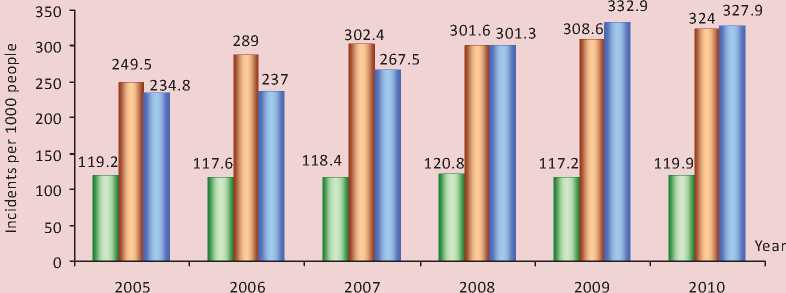
о Active tuberculosis □ Dia betes mellitus □ HIV
Source: Federal State Statistics Service.
Our country must meet public health indicators of countries with the same level of economic development by 2025.
Summing up what has been said above, we would like to suggest the following areas for further work:
-
1. Strengthening the role of the state in the development of public health:
-
- adoption of a new legislation;
-
- implementation of the national project “Health”;
-
- measures to improve the environmental protection;
-
- enhancement of measurement capabilities and standardization .
-
2. Transition to health protection:
-
- considering the health as an economic resource;
-
- revival and development of preventive medicine;
-
- development and implementation of economic incentives to improve health.
-
3. Changing the attitudes to our own health:
-
- adherence to a healthy lifestyle;
-
- selection of a family physician;
-
- upbringing the children with responsible attitude to the health.
Successful implementation of the proposed measures could significantly improve the quality of life in Russia and make the Russians more happy.
Список литературы Development of health economics for improving the quality of life
- Okrepilov V.V. Quality economics. St. Petersburg: Nauka, 2011.
- Aganbegyan A.G. How can we live long and stay healthy. Moscow, 2011.
- Science and Society. Physiology and Medicine of the XXI century: Abstracts of plenary reports at the St. Petersburg Scientific Forum. St. Petersburg, 2011.

